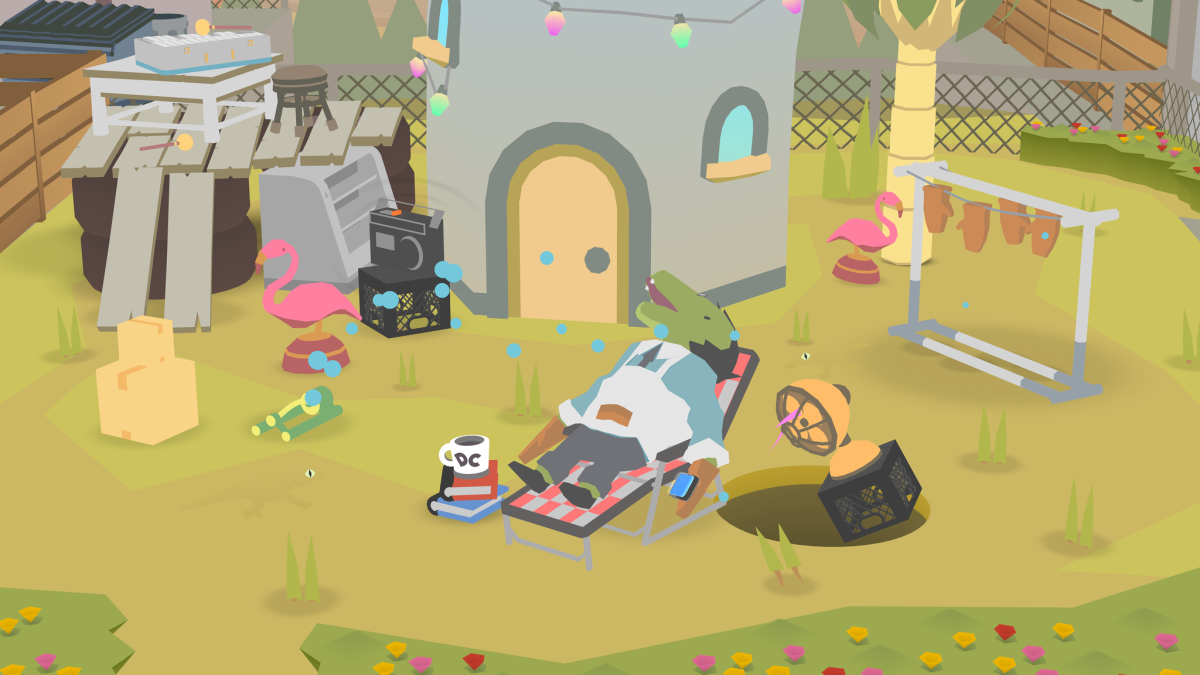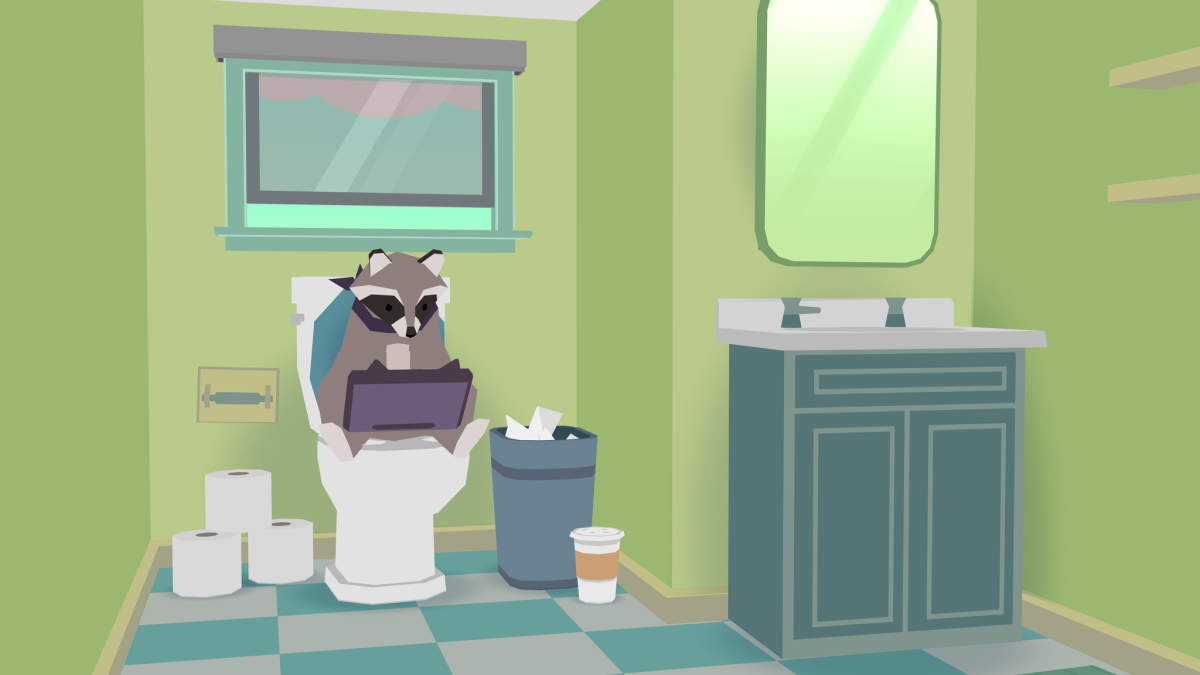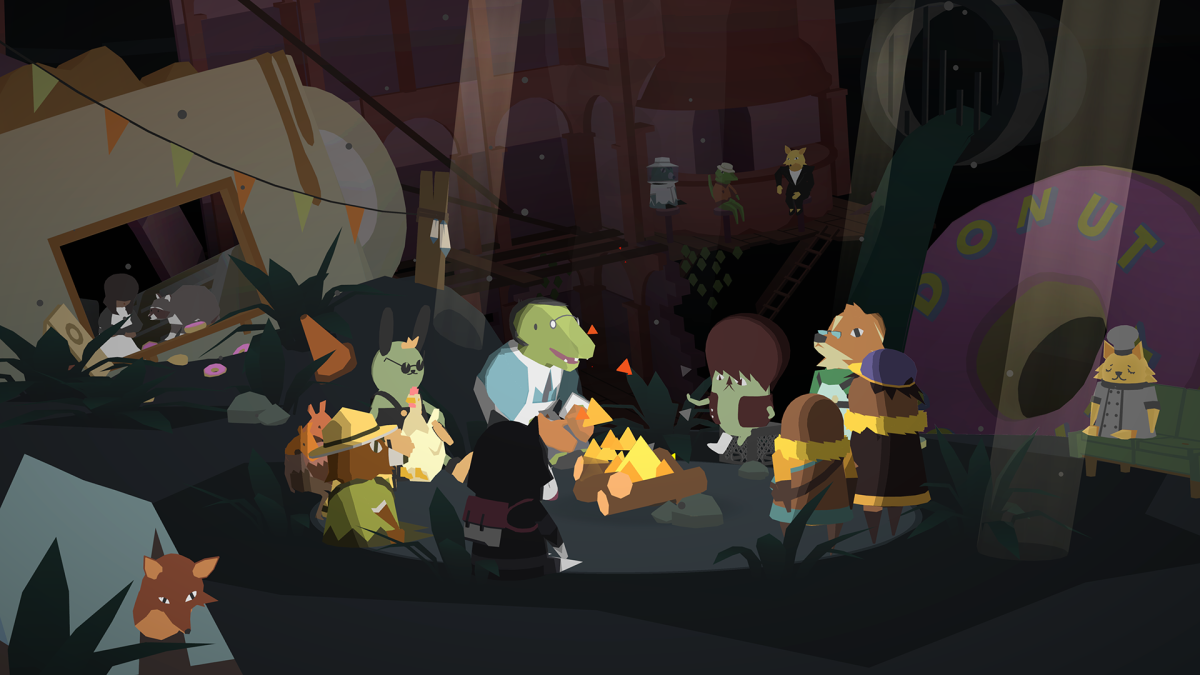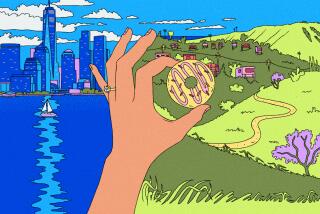Must Reads: Video game ‘Donut County’ asks big questions about gentrification in Los Angeles

- Share via
Forget Thanos, the Joker or even Maleficent. The most insidious pop-culture villain just may be a hole in the ground.
For though it is abstract in nature — a circular pit of darkness — the hole ultimately proves to be a rather familiar evil. In Ben Esposito’s independent game “Donut County” (available now for the PlayStation 4, iOS devices and home computers), the hole becomes an urban eraser.
Slowly and casually, the hole absorbs cutesy manifestations of Southern California. Whether it’s thinly veiled takes on Echo Park or Joshua Tree, the hole shows no remorse.
The elegant two- or three-hour experience’s rather sinister core is revealed as the player, in maneuvering the hole, assists the game’s true antagonists: a pack of raccoon gentrifiers.
These mammals start by assuming control of a mom-and-pop doughnut shop and soon build an empire that turns Southern California into a raccoon paradise. That means the cultures of previous inhabitants — crocodiles, bears, humans — get erased along the way.
Tonally, “Donut County” largely sidesteps the weight of such a concept. Esposito insists, for instance, that a requirement he had was that the game could be enjoyed without the story and without fear of its big ideas getting in the way of its core silliness (a hole swelling in size after it devours a car, for instance, or spitting back fireworks). “Donut County” ultimately was designed to be safe for the youngest of players.
And yet one can’t help but feel a sense of melancholy playing through “Donut County,” published by the interactive division of Annapurna Pictures (“Sorry to Bother You,” “Phantom Thread”). As the game unfolds, its themes start to hit closer to home. The raccoons, after all, aren’t exaggerated miscreants. Their fallacies are relatively common, and we probably know or have encountered someone with traits similar to the game’s lead raccoon, named BK.

The raccoons offer “Donut County” residents jobs with decent salaries, company stock options, healthcare, fancy new tech and a Southern California remade in their vision. As BK innocently (and ignorantly) says when describing his job, “I was just cleaning up the neighborhood.” Heck, the raccoons even build their own version of Disneyland: Raccoon Lagoon, “the happiest raccoon place on raccoon earth.”
Esposito began toying with the idea not long after graduating from New York’s Rensselaer Polytechnic Institute and relocating in 2011 to Los Angeles. He moved west to make games — Esposito previously worked on Giant Sparrow’s “What Remains of Edith Finch,” a thoughtful fantasy about tragedy and death — and saw himself as part of the problem, a tech industry gentrifier replacing local color with juice shops, gastropubs and converted warehouse live/work spaces.
Thus, “Donut County” became a game, in Esposito’s words, about the “gentrification in L.A. told through donuts.”
“It takes place in some version of Los Angeles,” Esposito says. “But I wanted it to have more of a slice of Southern California than just L.A. — that’s why the game starts out in the Mojave Desert and then each level moves closer to the center of L.A., which is obviously very nebulous because there is no real center.
“But it does end at the Griffith Observatory, like all good L.A. stories.”
Through short vignettes we get to know the “Donut County” residents. Most look on helplessly as the hole obliterates their livelihood, be it a cat-owned cafe — it earned a health grade of D — or a gator with his homey home (the raccoons may say run-down or, more bluntly, a “weird trash house”) in Echo Park. Wait, make that Gecko Park.
“I wanted to have different specific references to L.A., so there is a level called Gecko Park where one of the characters lives, and he’s the last one who lives in a tin can,” Esposito says. “He’s a crocodile character who’s just out sunning, and there’s a yoga studio that has moved in to his right, and fancy apartments to his left.”
At the end of each level we get a rundown on what we guzzled via the hole, which also illustrates how the raccoons view the world. Where the residents of “Donut County” see beauty, the raccoons see garbage that stands in the way of redevelopment. A Joshua tree, for instance, is described as an “old and ugly tree.” A trailer is a “dumpster you can attach to your car.” And the crocodile’s musical instruments exist solely to “make his neighbors mad.”
The raccoons are the type who move next to a rock club and then complain about the noise. And “Donut County” works because of how it uses humor. There’s an absurdity when BK, interrogated as to why he destroyed the cat cafe, shrugs and says, “I hate it.”
“I think the bittersweetness that you feel playing ‘Donut County’ is the core energy of the entire game,” Esposito says. “So its been really challenging to balance people’s expectations, because the game looks really cartoony and the game is made for kids and adults to maybe play together. But then there are also those moments at the end of levels where the music changes and I give you some extra time to sit with the nothingness. That tension is core to ‘Donut County,’ and I think it’s something that games do well.”
Everyone knows they’re playing a jerk.
— ‘Donut County’ creator Ben Esposito
In those moments, instead of making a bold statement, “Donut County” reveals our own contradictory nature.
After all, “Donut County” makes destruction joyful. The Disneyland-inspired level, for instance, could be seen as a revenge fantasy, one in which the former residents of “Donut County,” now homeless, eradicate the playful raccoon empire. Yet before the theme park is erased, Esposito lets the player have some fun with the digital rides.
“I really like the idea that the raccoons’ favorite place in L.A. is this virtual place,” Esposito says, “a place with a fake version of L.A. inside it.”
Esposito has no ill will toward Disneyland; he’s an annual passholder who’s at the park regularly. “But I do question myself,” he says. “I’m like, ‘Why am I doing this? Why am I going here every week? Why am I going to the fake version of the real thing?”

Over the past six or so years of development, the game shifted perspectives. The gentrification themes were originally meant to be more of a reveal late in the game, but Esposito noticed that most players immediately picked up on the fact that they’re playing someone nefarious.
“I thought it would be a big surprise, but everyone knows they’re playing a jerk,” Esposito says. So now the game is direct and tells players their role from the get-go.
“I know exactly who’s gonna download this, and I know who my target audience is,” Esposito says. “And that was the motivation behind switching up the perspective and making it front and center. It made it more personal, so it’s not just like, ‘Hey you’re evil, you suck.’
“I don’t know,” he continues, “a lot of people are aware of that.”
They’re aware that they’re evil?
“They’re aware that their presence somewhere means that someone else is not in their place,” he says, adding that “‘Donut County’ is not gonna give you the answers.”
“It’s a game, and it’s also for kids. But ‘Donut County’ can start you thinking about your role in the place that you live, and the way you’ve affected others.”
Follow me on Twitter: @toddmartens
More to Read
The biggest entertainment stories
Get our big stories about Hollywood, film, television, music, arts, culture and more right in your inbox as soon as they publish.
You may occasionally receive promotional content from the Los Angeles Times.











